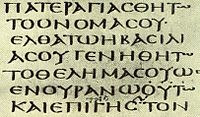Luke 11
[1] The book containing this chapter is anonymous, but early Christian tradition uniformly affirmed that Luke the Evangelist composed this Gospel as well as the Acts of the Apostles.[6] Eric Franklin notes the "appropriate" connection between this section and the end of chapter 10, where Mary's listening to Jesus has been commended rather than Martha's activism.[13] Meyer sees in this passage an example of the literary technique known as anacoluthon, an unexpected discontinuity in the expression of ideas.Baptist theologian John Gill suggests that "the allusion [in verse 23b] is either to the gathering of the sheep into the fold, and the scattering of them by the wolf; or to the gathering of the wheat, and binding it in sheaves, and bringing it home in harvest; and to the scattering of the wheat loose in the field, whereby it is lost".[14] Verses 37-54 enumerate a number of criticisms raised by Jesus against scribes (lawyers) and Pharisees, which are also recorded in Matthew 23:1–39.


chapter 10chapter 12Uncial 0191Gospel of LukeGospelNew TestamentChristianLord's PrayerparablesChristanonymousLuke the EvangelistActs of the ApostlesKoine GreekPapyrus 75Papyrus 45Codex VaticanusCodex SinaiticusCodex BezaeCodex WashingtonianusCodex AlexandrinusCodex Ephraemi Rescriptusdivided intodisciplesJohn the BaptistFrederic FarrarSermon on the MountMary's listening to JesusMarthaParable of the Friend at NightJan LuykenBowyer BibleeschatologicalKingdom of GodparableallegoricalprayeranacoluthonCodex Claromontanus VBaptistJohn GillWoes of the PhariseesscribesPhariseesMatthew 23Mark 12Luke 20Ministry of JesusParable of the Strong ManJonah 1Matthew 6Mark 3New King James VersionWayback MachineWestcott-Hort New TestamentBible in Basic EnglishLuke 10Luke 12Luke 1Annunciation to MaryElizabethand the shepherdsAdoration of shepherdsJohn the Baptist's BirthCensus of QuiriniusJesus' BirthCircumcisionPresentation at the TempleFinding in the TempleGenealogyBaptismTemptationCalling of MatthewCounting the costSermon on the PlainBeatitudesCalming the stormFeeding the 5000TransfigurationGreat CommandmentProdigal sonOlivet DiscoursePassion of JesusLast SupperPilate's courtCrucifixionBurialEmpty tombResurrectionAscensionBenedictusFishers of menMagnificatNew Wine into Old WineskinsNunc dimittis (Song of Simeon)Parable of the Unjust StewardRich man and LazarusThe four woes of JesusAbijahAndrewAugustusCaiaphasElishaGabrielHerod AntipasHerod the GreatJesus ChristJosephJoseph of ArimatheaJudas IscariotLazarusLysaniasMary, mother of JesusMary MagdaleneMary, sister of MarthaNaamanPhilip (apostle)Philip (tetrarch)Pontius PilateQuiriniusSimeonSimon PeterTheophilusThomasTiberius CaesarZebedee